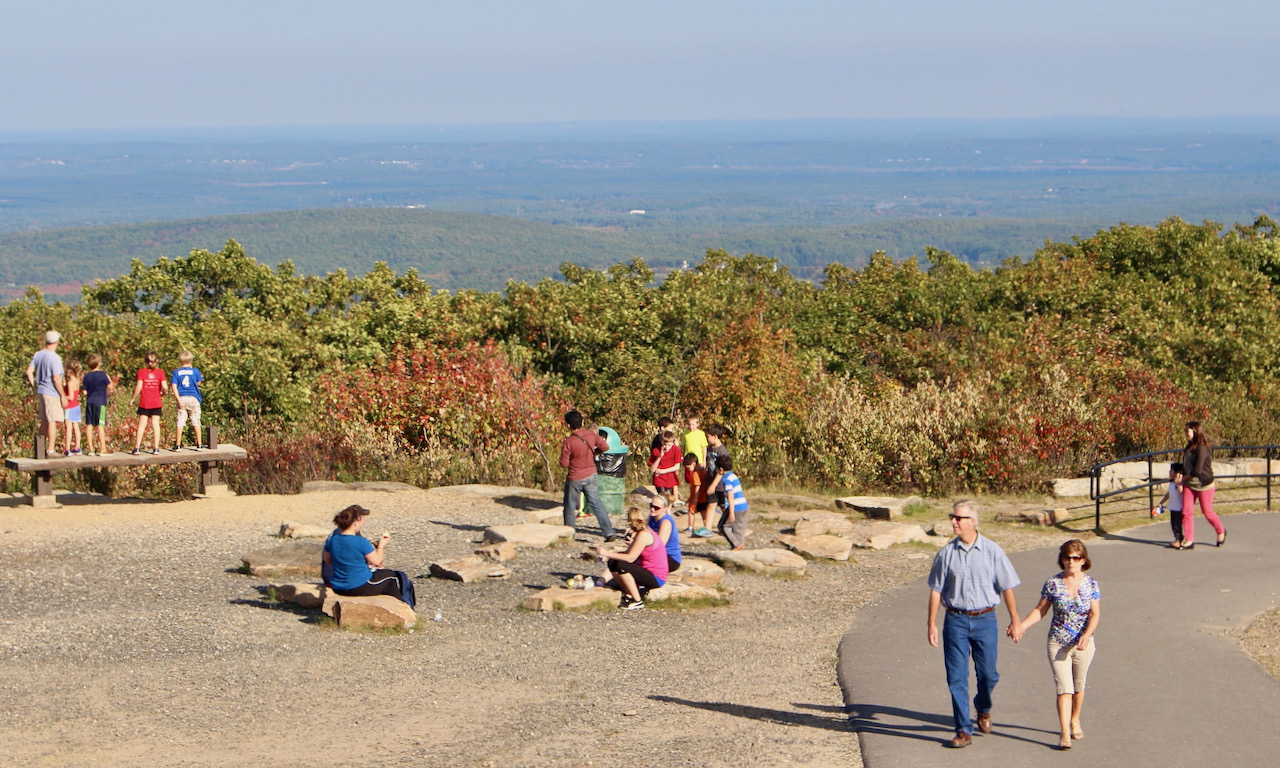Encompassing 3,000 acres of alpine meadows, ponds, streams, fields, and forests, including the largest known area of old growth forest in Massachusetts east of the Connecticut River, Wachusett Mountain State Reservation is part of an extensive greenway area that includes Leominster State Forest, Mass Audubon’s Wachusett Meadow Wildlife Sanctuary, and MassWildlife’s Susan B. Minns Sanctuary.
Seventeen miles of hiking and walking trails, including a section of the Midstate Trail, offer a variety of routes to explore. Additional recreational opportunities, including bird watching, cycling, and skiing abound. From the 2,006-foot summit, visitors can enjoy 360° views of the surrounding landscape, including Mount Monadnock to the north, Mount Greylock to the west, and the Boston skyline to the east.
The John Hitchcock Visitors Center is open daily featuring exhibits detailing the mountain’s unique geologic history, including the effects of the last glacial period. Exhibits also highlight Wachusett Mountain’s human history, from the Native Americans living in the area who gave the mountain its name, to the European colonists who settled the area.
The Wachusett summit road is accessible to vehicles from Memorial Day weekend to the last weekend of October.
This property is managed by the Massachusetts Department of Conservation and Recreation.
Following In Thoreau’s Footsteps
Henry Thoreau loved mountains, and of all the mountains he visited Mount Wachusett was one of his favorites. He could see it from Concord in the western horizon and even wrote poems about the mountain who, ” like me, standstill alone without society”.
Situated about 26 miles west of Concord, Thoreau visited Wachusett only twice in his life. His first visit began on July 19, 1842 as Thoreau and his friend, Richard Fuller (the younger brother of Margret Fuller) set out from Concord on foot. Wanting to “scale the blue wall in the western horizon” the two young men walked to Wachusett. Seeing the mountain in the distance for most of his life, Wachusett was almost mystical to Thoreau; he feared that climbing the mountain would ruin the “visible fairyland” he imagined Wachusett to be.
With backpacks, provisions, and a tent (which was so heavy they took turns carrying it), Thoreau and Fuller covered 25 miles on their first day, stopping in what is now West Sterling, Massachusetts. The next day they hiked up Wachusett and camped that night on the summit. The next day they headed back down and started for home; after spending the night in Harvard, Massachusetts, they parted company. Fuller walked west to Groton while Thoreau went eastward to Concord.
Thoreau would write an account of the excursion, calling it “A Walk to Wachusett”. It would appear in the January 1843 issue of The Boston Miscellany. The essay wouldn’t be published again in Thoreau’s lifetime but would appear in a posthumous edition (1863) of his travel and nature essays called “Excursions”.
Thoreau’s second excursion to Wachusett wasn’t for another 12 years and that time he took the train to central Massachusetts. The three day trip (October 19-21, 1854) was with two friends, H.G.O. Blake and Thomas Cholmondeley; they rode to Westminster, Massachusetts via the Fitchburg Railroad and the Vermont & Massachusetts Railroad and then walked the four miles to Wachusett from there. Instead of camping they trio stayed at the home of Reverend Daniel Foster, the former minister of the Concord Trinitarian Church. On the 21st the train had them back in Concord in just over an hour. Thoreau didn’t write up this visit to Wachusett in an essay, but he did, as usual, keep copious notes about it in his journal.
Today, the 3,000-acre Wachusett Mountain State Reservation offers plenty of natural and recreational opportunities. You can hike and bike trails in the summer and ski in the winter. You can also enjoy the scenic views from this 2,006-foot peak. State Reservation hours and parking fees vary by season.

